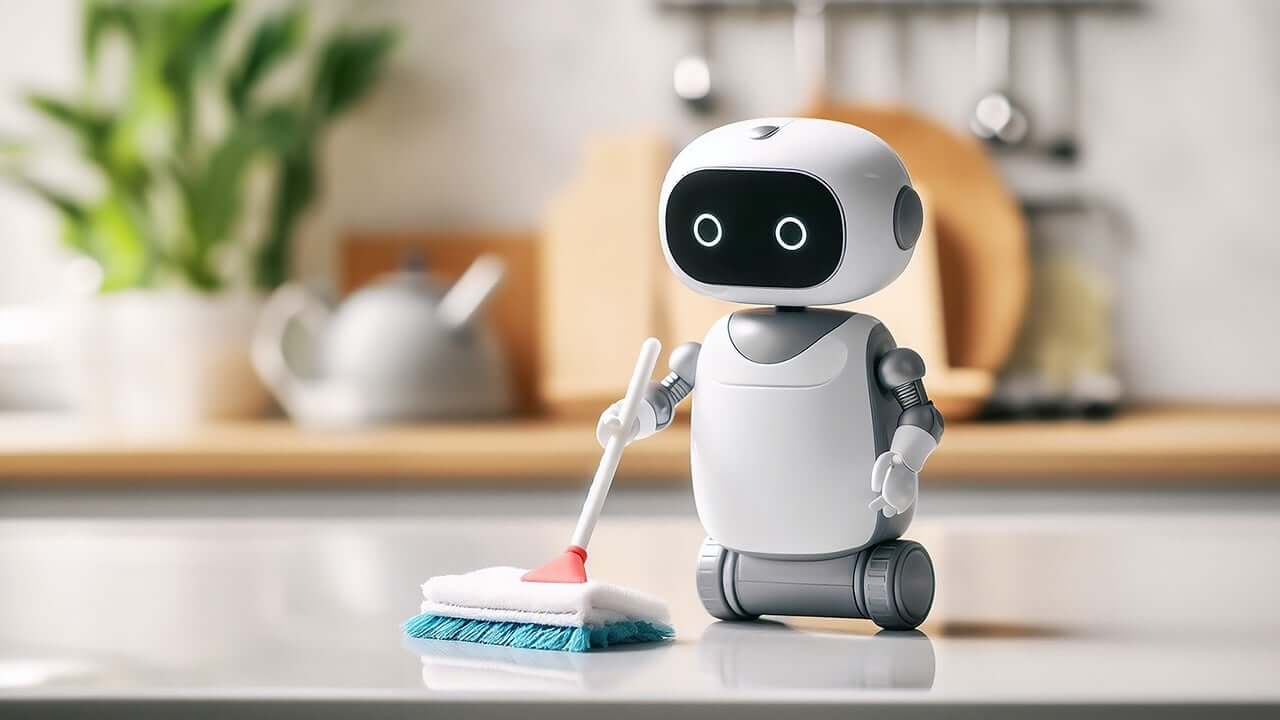Robotic cleaning systems for residential use have gained significant popularity, changing the way people approach household chores.
The rise of robot vacuums, window cleaners, and other robotic cleaning devices has had a notable impact on domestic life, offering convenience, efficiency, and improved home cleanliness.
In this detailed overview, we’ll examine the various aspects of robotic cleaning systems for residential use, including their technology, benefits, limitations, and their evolving role in modern households.
The Evolution of Robotic Cleaning Systems in Residential Settings
Robotic cleaning systems began to gain traction in the residential market with the introduction of robot vacuums in the early 2000s. Since then, technology has advanced, leading to more sophisticated systems with enhanced capabilities. This evolution can be attributed to advancements in sensors, artificial intelligence (AI), machine learning, and automation.
- Early Robot Vacuums: Early models were relatively simple, with basic navigation and limited cleaning capabilities. They often required frequent manual intervention and struggled with obstacles.
- Modern Robot Vacuums: Today’s robot vacuums are far more advanced, equipped with sophisticated sensors, AI algorithms, and smart connectivity. They can map rooms, avoid obstacles, and even empty their dustbins in some cases.
- Expansion into Other Areas: Beyond vacuums, robotic cleaning systems have expanded into other areas, such as robot mops, window cleaners, and pool cleaners, providing comprehensive solutions for residential cleaning.
Key Technologies in Robotic Cleaning Systems
Robotic cleaning systems for residential use rely on a combination of technologies to deliver effective cleaning and ease of use:
- Sensors and Mapping: Modern robots use LiDAR, cameras, and other sensors to map their environment, enabling them to navigate efficiently and avoid obstacles. This mapping capability allows them to create cleaning schedules and optimize their cleaning paths.
- AI and Machine Learning: AI algorithms enable robots to learn from their environment and adapt to changes. Machine learning helps them improve their cleaning efficiency over time.
- Smart Connectivity: Many robotic cleaners can connect to Wi-Fi and be controlled through smartphone apps or voice assistants. This connectivity allows users to schedule cleanings, monitor progress, and receive notifications.
- Autonomy and Automation: Robotic cleaners are designed to operate autonomously, allowing them to clean without constant supervision. Automation features, such as using filtered water, automatic docking and self-emptying, further enhance their convenience.
Benefits of Robotic Cleaning Systems for Residential Use
Robotic cleaning systems offer several key benefits for residential users, contributing to their growing popularity:
- Convenience and Time Savings: Robotic cleaners operate autonomously, allowing users to focus on other tasks while the robot cleans. This convenience can save significant time in daily routines.
- Consistent Cleaning: Robots can maintain a consistent cleaning schedule, ensuring that floors and other surfaces are regularly cleaned. This consistency can improve overall home cleanliness.
- Accessibility: Robotic cleaners are accessible to a wide range of users, including those with mobility issues or physical disabilities. They can help maintain cleanliness without requiring significant physical effort.
- Reduced Stress and Improved Quality of Life: By automating cleaning tasks, robotic cleaners can reduce the stress associated with household chores, contributing to a better quality of life.
- Enhanced Home Connectivity: The integration of robotic cleaning systems with smart home technologies creates a more connected and automated living environment. Users can control their robots through apps or voice commands, enhancing the smart home experience.
Limitations and Challenges of Robotic Cleaning Systems in Residential Settings
Despite their benefits, robotic cleaning systems also have limitations and face several challenges in residential use:
- Navigation Issues: While modern robots have improved navigation, they can still struggle with complex layouts, high furniture, or cluttered spaces. They may miss certain areas or require manual intervention.
- Battery Life and Power: Battery life can limit a robot’s cleaning range. Frequent recharging may interrupt cleaning cycles, and some robots may not return to their docking stations properly.
- Maintenance and Durability: Robotic cleaners require regular maintenance, including emptying dustbins, cleaning brushes, and checking sensors. Durability can be an issue if the robots are subjected to heavy use or harsh conditions.
- Limited Flexibility: Robots designed for specific tasks, like vacuuming, may not be versatile enough for other cleaning needs. Additional cleaning tools or manual intervention may be required for comprehensive cleaning.
- Cost and ROI: The cost of robotic cleaning systems can be significant, and users must weigh the initial investment against the time and effort saved. The ROI may vary depending on the cleaning requirements and usage frequency.
- Safety Concerns: Although generally safe, robotic cleaners can pose risks if not used properly. For example, robot vacuums might be a tripping hazard or get entangled in cords or fabrics.
- Compatibility with Smart Home Systems: Not all robotic cleaners are compatible with every smart home system, which can limit their integration and functionality in some households.
Privacy Concerns
Robotic cleaning systems, like robot vacuums and window cleaners, are becoming increasingly common in residential settings. While these devices offer convenience and efficiency, they also raise several ethical and privacy concerns.
As technology becomes more integrated into daily life, understanding these implications is crucial to ensure the safe and responsible use of robotic cleaning systems.
1. Data Collection and Privacy
One of the primary ethical concerns with robotic cleaning systems is the potential for data collection and privacy invasion. These robots often use sensors, cameras, and connectivity features that can inadvertently gather sensitive information about users and their environments.
- Data Collection: Robotic cleaning systems may collect data related to a home’s layout, cleaning patterns, and even personal objects or activities. This data could be used to improve the robot’s functionality but could also be misused or fall into the wrong hands.
- Connectivity and Cloud Services: Many robotic cleaning systems connect to the internet and use cloud-based services for remote control, software updates, and data storage. This connectivity raises concerns about data security and unauthorized access.
- Risk of Data Breaches: If the data collected by robotic cleaning systems is not properly secured, it could be vulnerable to cyberattacks, leading to potential breaches of personal information.
2. Informed Consent and User Awareness
Ethical concerns also arise when users are not fully informed about the capabilities of robotic cleaning systems and the potential risks involved.
- Lack of Transparency: Manufacturers might not always clearly communicate what data is being collected and how it will be used. This lack of transparency can lead to users unknowingly agreeing to invasive data practices.
- Informed Consent: Users should have the opportunity to provide informed consent regarding data collection and privacy practices. This requires clear and accessible information about the robot’s features and privacy policies.
- Consent of Others in the Household: Robotic cleaning systems in shared environments, like households with multiple occupants or communal living spaces, may collect data from people who haven’t given explicit consent. This raises ethical questions about the rights of all individuals in the space.
3. Potential for Misuse and Surveillance
Robotic cleaning systems with cameras or microphones can potentially be misused for surveillance or other invasive purposes.
- Unintended Surveillance: Robots with cameras, intended for navigation or other functions, can inadvertently capture private moments or sensitive information. This creates a risk of unintended surveillance.
- Misuse by Third Parties: If a robotic cleaning system’s data is accessible to third parties, there is a risk of misuse, such as unauthorized monitoring or tracking of users’ activities.
- Integration with Smart Home Systems: Integration with smart home systems can increase the risk of surveillance, as connected devices might share data or be accessed remotely.
4. Ethical Design and Security Measures
To address these ethical and privacy concerns, manufacturers of robotic cleaning systems should adopt ethical design principles and robust security measures.
- Privacy by Design: Manufacturers should incorporate privacy protections into the design of robotic cleaning systems, minimizing data collection and ensuring user control over their data.
- Secure Data Handling: Data collected by robotic cleaning systems should be encrypted and stored securely to prevent unauthorized access. Security measures should be regularly updated to address emerging threats.
- User Control and Opt-Out Options: Users should have control over what data is collected and should be able to opt out of unnecessary data collection. This includes the ability to delete data and reset the robot’s memory.
- Transparency and Communication: Manufacturers should provide clear and accessible information about the robot’s privacy practices and obtain informed consent from users. Communication should be open and transparent about any changes to privacy policies or security measures.
5. Regulatory Compliance and Ethical Standards
To ensure ethical practices in the use of robotic cleaning systems, there should be regulatory compliance and adherence to ethical standards.
- Compliance with Privacy Regulations: Manufacturers and users must comply with privacy regulations such as the General Data Protection Regulation (GDPR) in Europe or the California Consumer Privacy Act (CCPA) in the United States. These regulations establish guidelines for data protection and user rights.
- Ethical Standards and Best Practices: Industry standards and best practices should be developed to guide the ethical use of robotic cleaning systems. These standards can help ensure that privacy and security are prioritized in the design and use of these systems.
- Third-Party Audits and Certifications: Independent audits and certifications can help ensure that robotic cleaning systems meet privacy and security standards. This adds an additional layer of accountability and trust.
The Future of Robotic Cleaning Systems for Residential Use
The future of robotic cleaning systems in residential settings is likely to involve continued technological advancements and broader adoption:
- Improved AI and Automation: Future robots are expected to become more intelligent, with enhanced AI capabilities allowing for better navigation, learning, and adaptation to changing environments.
- Greater Connectivity and Interoperability: Robotic cleaning systems will likely become more integrated with smart home ecosystems, allowing for seamless control and interoperability with other smart devices.
- Increased Sustainability and Energy Efficiency: The focus on sustainability may lead to more energy-efficient robotic cleaning systems, reducing their environmental impact.
- Expanded Applications: As technology advances, robotic cleaning systems could expand into new areas, offering more comprehensive cleaning solutions for residential users.
Robotic cleaning systems for residential use have revolutionized the way people approach household cleaning. Their convenience, consistency, and ability to operate autonomously make them valuable tools for modern homes.
However, they also face challenges that require ongoing technological innovation and thoughtful integration into residential environments.
As these systems continue to evolve, they are likely to play an increasingly important role in creating cleaner, more efficient, and more connected homes.






